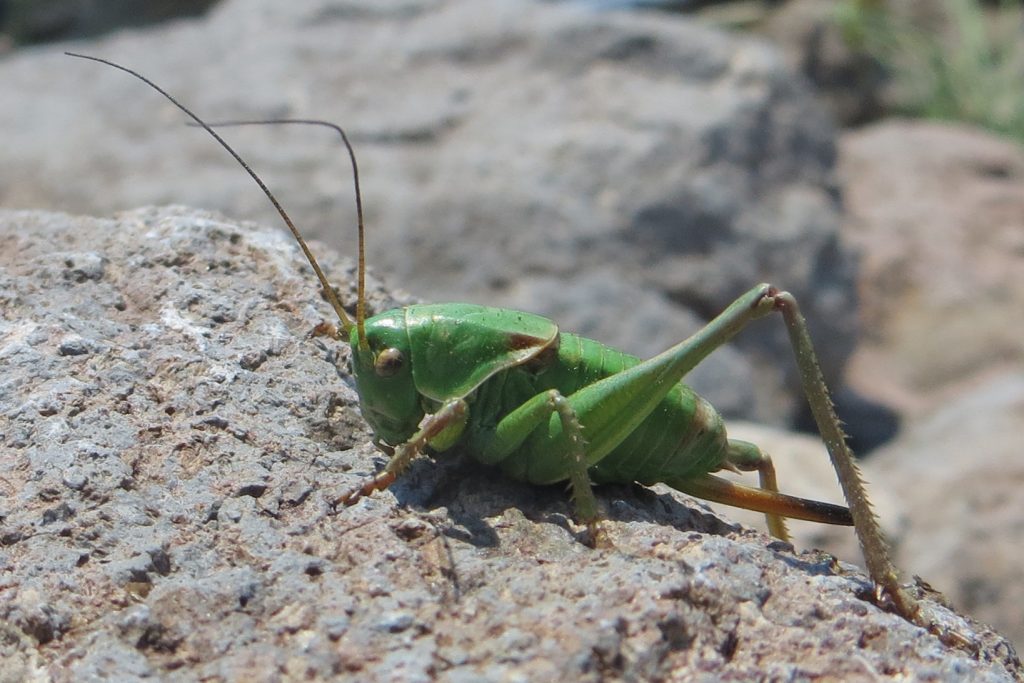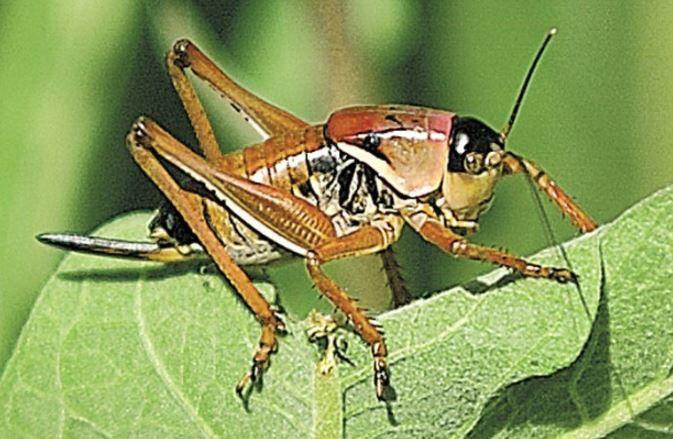
Mormon crickets are voracious eaters and have sharp, powerful mandibles for chewing many kinds of plants. Their mandibles can easily chew into fruit. Feeding damage increases as the nymphs mature.
Mormon crickets will strip trees of foliage and feed on the directly on the fruit.
The common name is derived from this pest’s destruction of the crops of Mormon settlers in the mid-1800s.
It is native throughout western North America in sagebrush areas, rangelands, and grasslands, and is subject to population outbreaks that cause result in serious agricultural losses.
Evidence for the same is given below:
Mormon crickets populations continue to rise
February 19, 2019
SPARKS – Rural Nevada’s arid landscape is covered in snow but it won’t be long before bugs start hatching.

The Nevada Department of Agriculture, in cooperation with USDA’s Plant Protection and Quarantine program, is conducting a series of public meetings on proposed Mormon cricket and grasshopper population management this week.
“Mormon cricket and grasshopper populations have been on the rise for the last couple of years,” Jeff Knight, state entomologist for the NDA, said. “Significant numbers were found north of Reno in the Red Rock area, south of Winnemucca, near Paradise Valley and in and around Austin last year.”
‘Spraying insecticide is not an option’: Swarms of Mormon crickets invade Oregon
By ERIC MORTENSON, Capital Press
Friday, June 23rd 2017
SALEM, Ore. (AP) — An infestation of voracious Mormon crickets in the Arlington area of north-central Oregon has residents scrambling to protect farm fields and home gardens.
Ione resident Alison Ogden said people in Arlington have spent thousands of dollars battling the bugs on their own over the past couple of weeks.
“Some people don’t have air conditioning and can’t even open their windows for fear the bugs will enter homes,” she said in an email to the Capital Press.
Ogden said she and her husband, Jarrod, farm a few miles east of town, and anxiously check the crickets’ presence every day. She said the pests could do significant damage to their crops. “And because we have millions of leaf cutter bees working in the alfalfa seed fields, spraying insecticide is not an option,” she wrote.
Insecticides have proven to be ineffective against the Mormon crickets. Physical barriers and ditches have been erected to prevent bands from entering the orchards. But this happens to be a tedious work. So what can be used efficiently to keep the Mormon crickets away from your plants?
C Tech Corporation offers a range of low toxic and low hazard insect aversive repellent, which can be successfully used to keep pesky creatures at bay.
Combirepel™ can be easily described as insect aversive repellent, used also against all types of insects and which works on the mechanism of repellency. It means that it does not kill the target insects but only repel them, thus balancing the ecology and helping in maintaining the goal of sustainability.
This product can be easily used against a number of insects.
The product available in the form of masterbatch can be incorporated into the base polymer of applications like the wire and cables, pipes, agricultural films, and mulches, irrigation pipes etc.
The lacquer can be applied as a topical application on the fence, wooden objects, furniture, ceilings, frames, etc.
Combirepel™ liquid concentrate can be diluted in paints in a pre-determined ratio can be applied on walls and many other end applications to keep the Mormon crickets away from homes, buildings and other public places.
CombirepelTM pest repellent spray can be sprayed on infested and susceptible
Combirepel™ is thermally stable and does not degrade on exposure to heat and sunlight. It does not kill or harm the insect but repels them. It does not volatilize and does not degrade the soil. It is RoHS, RoHS2, ISO, EU BPR, REACH, APVMA, NEA compliant and FIFRA exempted.
Contact us at technical.marketing@ctechcorporation.com to keep the pests away.
Also, visit our websites:
http://www.ctechcorporation.com/
http://www.rodrepel.com/
http://www.termirepel.com/
http://www.combirepel.com/
Follow our Facebook pages at:
1] https://www.facebook.com/Combirepel-411710912249274/
2] https://www.facebook.com/Termirepel-104225413091251/
3] https://www.facebook.com/Rodrepel-120734974768048/
Follow us on our Twitter pages at:
1] https://twitter.com/rodrepel
2] https://twitter.com/termirepel
3] https://twitter.com/combirepel
